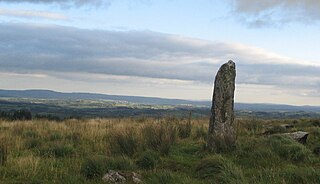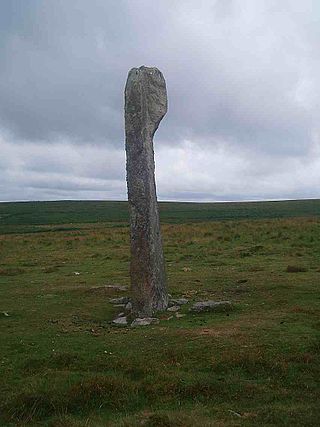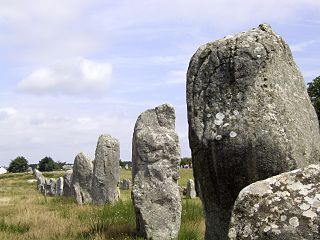
A menhir, standing stone, orthostat, or lith is a large upright stone, emplaced in the ground by humans, typically dating from the European middle Bronze Age. They can be found individually as monoliths, or as part of a group of similar stones. Menhirs' size can vary considerably, but they often taper toward the top.

A megalith is a large stone that has been used to construct a prehistoric structure or monument, either alone or together with other stones. There are over 35,000 in Europe alone, located widely from Sweden to the Mediterranean sea.

A tumulus is a mound of earth and stones raised over a grave or graves. Tumuli are also known as barrows, burial mounds or kurgans, and may be found throughout much of the world. A cairn, which is a mound of stones built for various purposes, may also originally have been a tumulus.

Drizzlecombe or Thrushelcombe is an area of Dartmoor in the county of Devon, England, containing a number of Bronze Age stone rows, cairns and menhirs.

The Nordic Bronze Age is a period of Scandinavian prehistory from c. 2000/1750–500 BC.

The Björketorp Runestone in Blekinge, Sweden, is part of a grave field which includes menhirs, both solitary and forming stone circles.

The stone ship or ship setting was an early burial custom in Scandinavia, Northern Germany, and the Baltic states. The grave or cremation burial was surrounded by slabs or stones in the shape of a boat or ship. The ships vary in size and were erected from c. 1000 BCE to 1000 CE.

Kilmartin Glen is an area in Argyll north of Knapdale. It has the most important concentration of Neolithic and Bronze Age remains in mainland Scotland. The glen is located between Oban and Lochgilphead, surrounding the village of Kilmartin. In the village, Kilmartin Museum explains the stories of this ancient landscape and the people who dwelt there. There are more than 800 ancient monuments within a six-mile (ten-kilometre) radius of the village, with 150 monuments being prehistoric. Monuments include standing stones, a henge monument, numerous cists, and a "linear cemetery" comprising five burial cairns. Several of these, as well as many natural rocks, are decorated with cup and ring marks.

The Sieben Steinhäuser is a group of five dolmens on the Lüneburg Heath in the NATO training area of Bergen-Hohne, in the state of Lower Saxony in northern Germany. The stones are considered to be part of the funnelbeaker culture. The gravesite was granted protected cultural monument status in 1923.

The Carnac stones are an exceptionally dense collection of megalithic sites near the south coast of Brittany in northwestern France, consisting of stone alignments (rows), dolmens, tumuli and single menhirs. More than 3,000 prehistoric standing stones were hewn from local granite and erected by the pre-Celtic people of Brittany and form the largest such collection in the world. Most of the stones are within the Breton municipality of Carnac, but some to the east are within neighboring La Trinité-sur-Mer. The stones were erected at some stage during the Neolithic period, probably around 3300 BC, but some may date to as early as 4500 BC.

A grave field is a prehistoric cemetery, typically of Bronze Age and Iron Age Europe.

The Locmariaquer megaliths are a complex of Neolithic constructions in Locmariaquer, Brittany. They comprise the elaborate Er-Grah tumulus passage grave, a dolmen known as the Table des Marchand and "The Broken Menhir of Er Grah", the largest known single block of stone to have been transported and erected by Neolithic people.

Sollerön is the largest island in Lake Siljan and a locality situated in Mora Municipality, Dalarna County, Sweden. It had 901 inhabitants in 2010.

Stenkyrka is a populated area, a socken, on the Swedish island of Gotland. It comprises the same area as the administrative Stenkyrka District, established on 1 January 2016.

Anundshög is a tumulus near Västerås in Västmanland, the largest in Sweden. It has a diameter of 60 metres (200 ft) and is about 9 metres (30 ft) high.

Stenehed is an Iron Age grave field located about 1 km southwest of Hällevadsholm, Munkedal Municipality, Västra Götaland County, Sweden. The area contains about 45 graves, a stone circle, a stone ship, and a row of menhirs.

Gnisvärd, is a fishing village in Tofta on the central west coast of the island of Gotland, Sweden. Gnisvärd is mostly known for its stone ships and harbor.

Jordbro Grave Field is located in Haninge kommun in the southern part of Stockholm County, Sweden. It is thought to be the largest grave field dating from the Iron Age in the Nordic countries. It is situated south of the small town of Jordbro, roughly one kilometer from Jordbro train station, or approximately one and a half kilometers north of Västerhaninge municipality station. Southeast of the grave field is Gullringskärret nature preserve.

Brederode was a ship of the line of the Maas Admiralty, part of the navy of the United Provinces of the Netherlands, and the flagship of the Dutch fleet in the First Anglo-Dutch War. Throughout her career, she carried from 49 to 59 guns. She was named after Johan Wolfert van Brederode, the brother-in-law of stadtholder Frederick Henry, Prince of Orange.



















